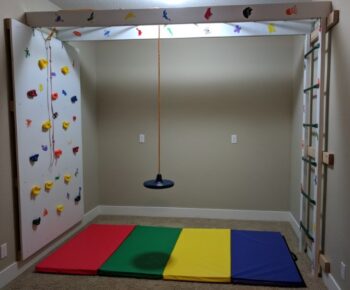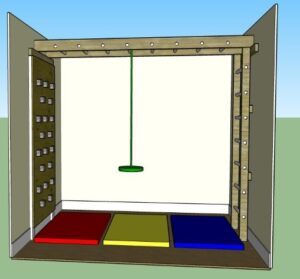Goal: What can three kids below 10 years of age do to burn off their seemingly unlimited reserves of energy, especially in those cold winter months? A significant amount of soul searching (ahem, those Pinterest ideas) gave some ideas, and a climbing activity wall with some monkey bars came up forefront of all.
Location: We have a 10′ x 10′ x 10′ spot in our basement that doesn’t get used much other than for throwing kids toys around and collecting dust. Besides, it’s a chore for adults to have the kids pick up after themselves. The space is intended for a basement bar, but we don’t drink. So, we upcycled it to build an activity wall.


Design: Most ideas I found online were either climbing wall only or a jungle gym with just ladders and ropes. I pulled the features that work the best for our basement, and mocked up a 3D model on Google Sketchup program with a climbing wall on one side, ladders on the other, both connected by a railing of monkey bars. Check out the interactive 3D model on the right hand side here, to get a feel for the design.
Design considerations:
- Dimensions: Check length, width, and height where the jungle gym will be installed. You will need enough clearance between the top of the monkey bars and the ceiling
- Monkey bar rungs: I first thought I’d put holes in the horizontal beams (the monkey bars) and run PVC pipes or wooden dowels through them. You can see this in the Sketchup representation. However, this is not suggested for multiple reasons:
- It’s not trivial to line up and drill holes through two pieces of studs together.
- The holes should not be too big for dowels to simply slip out of the holes, and not too small for dowels to be seated within the holes.
- Of course, if a dowel breaks sometime down the line, it will become next to impossible seating another dowel through the holes.
- For this reason, I chose to buy steel ladder rungs and place them on top of the rails instead of drilling holes through the horizontal studs.
- Climbing wall plywood:
- If your project is in a basement, I would suggest the base of the climbing wall plywood be off ground. This will prevent the plywood from any potential water damage (floods, broken sump pump, water leaks, etc.) and hence rot. Fixing it just above the baseboard level should work.
- Typical plywood sheets come in 4′ x 8′ sizes. I cut an inch off to make it a 4′ x 7′ so it is off-ground and there is enough clearance on the top to hold horizontal studs with at least a foot distance to the ceiling.
- Do not attempt to nail plywood directly to the drywall. It is hard to figure where studs behind the drywall are, with plywood held against the wall. Instead, screw in 2 x 4 studs in horizontal direction into drywall studs.
Things needed:
- Climbing wall: 4 x 8 Pine Plywood sheet (at least 23/32″ thick)
-
- Click here for 4 x 8 Plywood sheet from Lowe’s
- Climbing rocks from Amazon
